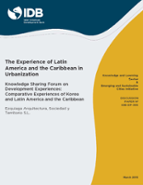The Experience of Latin America and the Caribbean in Urbanization: Knowledge Sharing Forum on Development Experiences: Comparative Experiences of Korea and Latin America and the Caribbean
Date
Mar 2015
The developing region that has experienced one of the greatest urban growth in the world is Latin America and the Caribbean (LAC). More than 80% of its population currently lives in cities and this figure is projected to reach 90% in 25 years. As part of this process, we can identify different urbanization trends across the region: slow growth rates of megacities due to lower levels of rural-urban migration and greater intra-city migration; high growth rates of mid-size cities; and urban footprints growing faster than populations. Therefore, this more contained growth in larger cities, the existence of a 'demographic bonus'in the next 30 years, and new poles of development in secondary cities offer new opportunities to grow in a more sustainable and equitable way while addressing existing challenges in cities. Rapid urban growth in the countries of LAC has posed a series of challenges that cities, especially intermediate cities, must address to ensure their sustainability in the coming years. Those challenges include limited mobility, poor urban planning, pollution, increased vulnerability to natural hazards, inequity, lack of compliance with labor and building regulations, unemployment, crime, and weak institutional and fiscal capacity, among others. These conditions undermine cities' sustainability and reduce the quality of life of their inhabitants. Given this context, the Bank has developed the Emerging and Sustainable Cities Initiative (ESCI) as a particular approach to help mid-size cities understand their challenges and address them in a more integrated way based upon a model of efficiency in planning and the use of resources that prioritizes sustainability and a higher quality of life for all citizens. The ESCI's action-oriented methodology prioritizes projects in critical areas for sustainability, promoting a better quality of life by strengthening planning, incorporating climate change features, and ensuring citizenship engagement. From the ESCI's experience in more than 20 cities in LAC, important lessons have been learned: introducing adaptation and mitigation measures is an opportunity to address environmental issues and limit the impact of climate change; urban economic development should be based on dense, compact, efficient cities, with mixed land use, and concrete actions to generate productive employment; planning should be considered a basic tool for sustainable urban development and growth; and finally, fiscal capacity should be strengthened with greater access to financial resources and connectivity. Cities that cannot provide an adequate quality of live and preserve physical and environmental assets for future generations will not be competitive. These cities will have a tough time attracting investments and generating productive jobs. As a result of ESCI's learning process, we have realized that it is necessary to examine in a more direct and detailed manner the competitiveness of a city proposing concrete actions to increase investments and to generate productive employment. Involving civil society in city planning and engaging the private sector in urban infrastructure services are also key ingredients of a competitive and successful city. As part of the Bank's knowledge dissemination series, this document exhibits the Latin American and Caribbean experience in terms of urbanization, the identification of the challenges posed by this trend, the IDB's approach to promote the sustainability of LAC mid-size urban centers, the lessons learned from how those challenges are being solved, and their impact on medium-term sustainability of cities and their quality of life.




